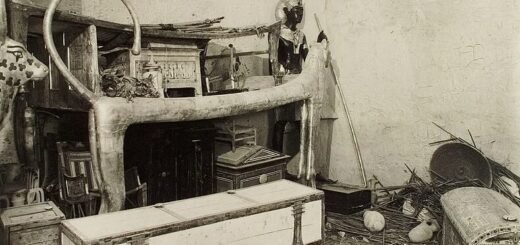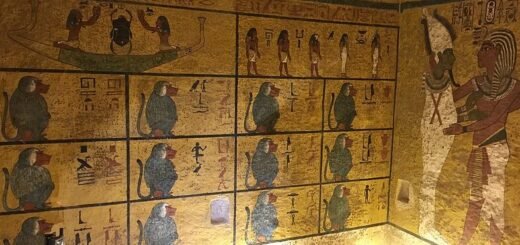Tutankhamun: History, Accomplishments and Facts
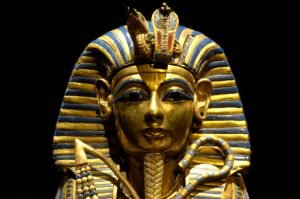
King Tutankhamun (c. 1342 BCE – c. 1323 BCE)
Ancient Egypt’s famous boy-king Tutankhamun, also known as Tutankhamen, was a pharaoh from the 18th dynasty of Egypt. Commonly known today as “King Tut”, Tutankhamun was a young 8/9-year-old boy who inherited the throne from his father, the “heretic Pharaoh” Akhenaten (Akhenaton) in the year c. 1333 BCE.
Tutankhamun would go on to have an unremarkable reign for 10 or so years. All throughout the course of his reign, King Tut immersed himself in the daunting task of reversing all his father’s religious policies. Along with his trusted royal advisers, Ay and Horemheb, Tutankhamun returned ancient Egypt to its polytheistic religious life.
However, the stigma attached to his father Akhenaten’s reign proved very difficult for the young king to shake off. Under bizarre circumstances, Tutankhamun’s life was cut short in 1323 BCE. He was probably in his late teens when he died.
Birth of Tutankhamun
Because it is widely held that Tutankhamun inherited the throne around 1333 BCE, at the age of nine, we can say that he was born around 1342 BCE. Archaeological findings place him as the son of Pharaoh Akhenaten (also known as Amenhotep IV). Not much is known about Tutankhamun’s mother, whom archaeologists like to refer to as the Younger Lady. As a matter of fact, to this day, archaeologists still do not know her name. However, it is believed that his mother and father were siblings. Back then, it was not uncommon for the pharaoh to marry (i.e. as queen consort) his own sister or mother. Ancient Egypt was simply rife with intra-sibling/family marriages.
Egyptologists believe that Tutankhamun was born and raised in Amarna, Egypt’s administrative and religious capital. Amarna, which was built from scratch by Tutankhamun’s father, Pharaoh Akhenaten, was dedicated solely to the worship of Aten, the sun god. Akhenaten was the son of Pharaoh Amenhotep III.
Read More: King Amenhotep III’s Greatest Accomplishments
Meaning of his name
Due to his father’s radical reformation, Tutankhamun must have spent his childhood being a monotheist. Archaeologists state that Pharaoh Akhenaten’s reign is most famous for being the only point in time when Egyptians largely worshiped one god, Aten the sun god.
The above explains why at the time of his birth he was given the name Tutankhaten. This name translates as “the living image of Aten”.
Tutankhamun’s Reign
In the latter years of Akhenaten’s reign, Egypt had a regent called Smenkhkare. Shortly after Akhenaten died, Smenkhkare served as the regent. And upon the death of Smenkhkare, the 9-year-old Tutankhamun became pharaoh of Egypt.
As tradition demanded, Tutankanmun got himself a wife. He married one of Akhenaten’s daughters – Ankhesenamen (Ankhesenamun).
Due to his young age and relative inexperience, it is likely that Tutankhamun left the actual governance of Egypt in the hands of older and much wiser advisers. The most famous of these advisers were Ay and General Horemheb.
Ay was Tutankhamun’s grand vizier. He wielded significant power in Egypt, steering the domestic affairs of the king’s court. On the military side of things, Tutankhamun entrusted Horemheb to supervise Egypt’s foreign conquests. Together Ay and Horemheb helped steer the affairs of Egypt to great heights.
With Egypt still reeling from Akhenaten’s monotheistic religious institutions, it was not long before Tutankhamun abandoned the ways of his father. In his third year, the young pharaoh collaborated with his trusted advisers and re-institutionalized Egypt’s polytheistic religious beliefs.
Major Accomplishments of King Tut
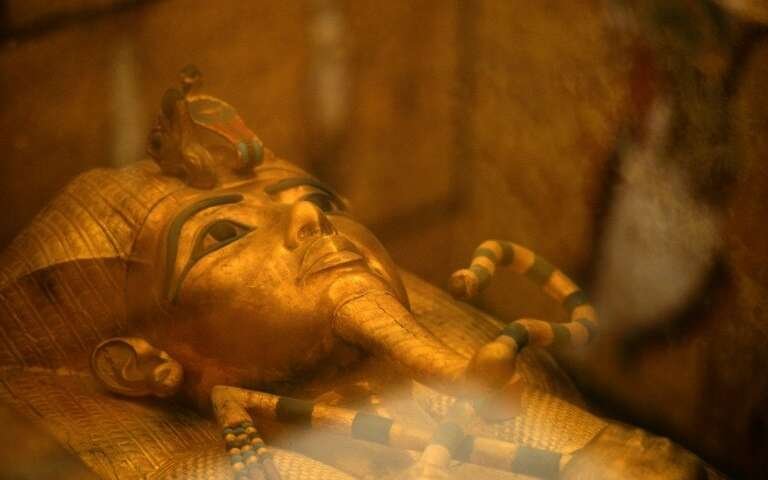
King Tutankhamun (c. 1342 BC – c. 1323 BC), the Famous Boy-king of Ancient Egypt
Aside from his very famous tomb, Tutankhamun’s name gets brought up largely because of the vast amount of reforms that he was able to achieve in his brief reign. Bearing in mind that he was a young and disabled pharaoh, the following achievements of King Tut would surprise you:
Tutankhamun brought back ancient Egypt’s religious institution that had been dismantled by his predecessor, Pharaoh Akhenaten. The old religious rituals, priests, temples and artifacts were all restored during Tutankhamun’s 10-year rule.
Another very crucial achievement of King Tut was that he moved Egypt’s capital back to Thebes. The reign of Akhenaten saw the capital move from Thebes to Armara/Akhetaten. It is believed that Thebes as the new capital of Egypt saw some level of improvement under King Tut.
Also, King Tut put up several monuments and temples at Karnak in honor of Amun-Ra, the sun god. In Luxor city, Tut helped retrieve or restore religious artifacts that were ceased during his predecessor’s reign.
In honor of the old polytheistic Egyptian pantheon, the pharaoh changed his name from Tutankhaten to Tutankhamun. The ‘mun’ in the name was to symbolize his newfound devotion to Amun (Amon), the supreme god of creation and the sun. His new name translates into “the image of Amun, the god of life”. As a result of such moves, Amun (also known as the sun god Ra) was restored as ancient Egypt’s supreme god. All over Egypt, shrines, temples, and priests of Amun, as well as other gods and goddesses, were brought out and given the reverence that they deserve.
Tutankhamun’s religious decrees did not seek to denigrate Aten’s temples or temples. Neither did the pharaoh punish Aten worshipers and priests. The god Aten was simply added to the plethora of deities in the Egyptian Pantheon.
Finally, Tutankhamun was partly responsible for the revival of the ailing Egyptian economy after ascending the throne. Many archaeologists have stated that the ancient Egyptian economy took a nose dive all throughout the reign of Akhenaten. His predecessor arrested priests and noblemen for failing to join the monotheistic ideology of Akhenaten. As a result of these persecutions, the economy tanked quite considerably. It was up to King Tut and his advisers to put the economy back on track by reversing Akhenaten’s ‘heretic’ policies.
Exactly how did Tutankhamun die?
After spending about a decade on the throne, King Tutankhamun died in c. 1323 BCE aged 19. Towards the later years of his reign, the pharaoh was plagued with several illnesses. It is likely that he died as a result of an infection to a broken leg, gangrene perhaps.
A 2010 archaeological report stated that Tutankhamun might have succumbed to malaria. After analyzing his remains, the report stated that malaria was probably the likeliest cause of King Tut’s death.
Using state-of-the-art scanning devices to scan the skull of King Tut’s, archaeologists discovered a deep hole behind the skull. They posit that Tutankhamun may have been assassinated by one of his courtiers. Alternatively, it is likely that he may have simply fallen off his chariot and struck his head against a sharp object. The former theory seems more plausible than the latter, the researchers posited.
There is a third theory as well. Some scientists attribute the hole in Tut’s skull as a typical case of mummification gone wrong. The ancient Egyptians were not the aptest of human anatomists; therefore, it is probable that an embalmer, while in a haste to bury the king’s body, mistakenly struck a hole in the skull.
Tutankhamun’s Reputation and Succession
With no children to his name, Tutankhamun’s unexpected death left his kingdom without a natural heir. After his death, his grand vizier, the noble Ay, inherited the throne. Shortly after Ay’s reign, King Tut’s renowned general, Horemheb, became king as well.
Archaeologists have stated that Tutankhamun’s death was so unexpected that the incoming pharaoh was left with no choice than to hurriedly bury him. This would probably explain why his tomb had so many treasures confined to a very small-sized tomb.
Another theory posits that Tutankhamun’s initial association with his father’s heretic beliefs (the Amarna period) may have posthumously tarnished his reputation. The ancient Egyptians wanted nothing more than to quickly do away with all memories and monuments that in some way reminded them of those heretic rulers and days. Unfortunately, this tarnished legacy and reputation of Tutankhamun resulted in his name unceremoniously eliminated from many ancient antiquities and monuments.
King Tutankhamun’s Tomb and Remains
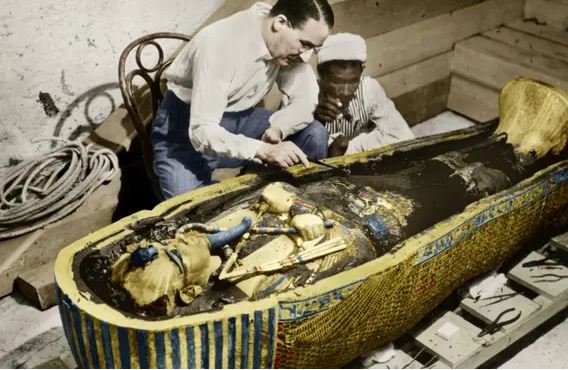
British archaeologist Howard Carter made the discovery in November 1922. Image: theguardian.com
Regardless of how he died, Tutankhamun’s tomb (at the Valley of the Kings – KV 62- Luxor ) has for close to a century bewildered patrons of art and archaeologists all over the world.
Discovered by British archaeologist Howard Carter on November 26, 1922, Tutankhamun’s inner burial chamber was left untouched and completely intact for about 3000 years.
To this day, Tutankhamun’s tomb and mummified remains are considered by many as some of the most significant archaeological finds in human history. To put things into perspective, it took Howard Carter and his men a staggering 10 years to catalog the vast treasures and artifacts located in Tutankhamun’s tomb.
Treasures unearthed in King Tut’s Tomb
The vast amount of treasures (over 5000 artifacts) that were discovered on that faithful day of November 26, 1922, have made Tutankhamun an absolute legend in our era. Without a doubt, he enjoys more fame now than he did when he was pharaoh or shortly after his death. Here are some of the treasures that were found in King Tut’s tomb:
- A three-nested burial coffin (the innermost one was made of complete gold);
- Golden death mask that weighed about 20 pounds;
- Several jewelry and amulets;
- Shrines made of gold;
- A granite sarcophagus;
- Six chariots;
- A leopard-skin cloak
- Furniture, clothes, weapons, walking sticks, and chariots;
- 30 wine jars;
- 46 bows; and
- Four game boards.
Many archaeologists believe that those treasures and artifacts were placed in the tomb in order to make sure that King Tut never lacked anything in the afterlife. They were carefully selected for him so that he could conveniently make it into the arms of the god Osiris in the afterlife.
The leopard-skin cloak was often associated with the god Anubis – the god that protected tombs and burial places. The cloak, as well as a miniature statue of Anubis, was placed in the tomb so as to ward off evil spirits and grave robbers.
Underworld Deities in Ancient Egyptian Religion and Mythology
Significance of Tutankhamun

King Tutankhamun’s significance
Considering how ancient the story of Tutankhamun is, his significance rests in his tomb and sarcophagus. The relatively untouched tomb of King Tut revealed so much about ancient Egypt than any other ancient Egyptian artifact to date.
Aside from this, Tutankhamun’s significance 3,000 years ago would have laid in the fact that he boldly restored the old gods and goddesses of Egypt.
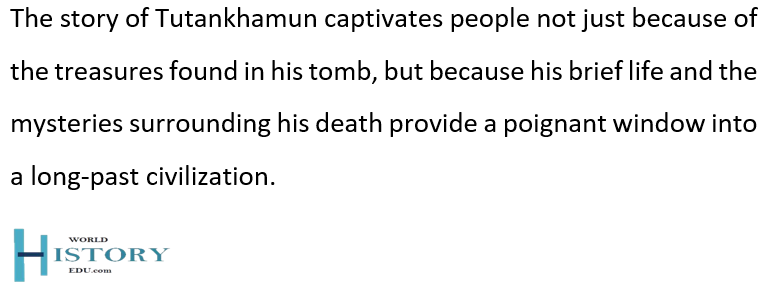
Interesting Facts about King Tut
- He reigned during the New Kingdom of Egypt. With no offspring of his, Tutankhamun is commonly considered as the twelfth monarch of the 18th Dynasty of Egypt.
- Historians and archaeologists commonly refer to Tutankhamun’s unknown (currently unknown) mother as “the Younger Lady”. Both her tomb and Pharaoh Akhenaten’s were unearthed at the Valley of Kings, KV35, and KV55 respectively.
- It is believed that Tutankhamun and his wife Ankhesenamun had a number of stillbirths or miscarriages.
- Tutankhamun was not the healthiest of royal children. In fact, he must have been plagued by a plethora of illnesses growing up. Years and years of inbreeding among the royal family must have taken a toll on the physical and mental traits of some royal children. Many ancient Egyptian royal children were born slightly deformed in one shape or the other.
- Archaeological findings reveal that Tutankhamun was probably lame and disabled. We know this because his tomb had several walking sticks and canes. The ancient Egyptians were devout believers in the afterlife. Hence they probably placed those walking sticks in his tomb in order to help him in his afterlife.
- Due to unexplained deaths of people associated with the excavation of Tut’s tomb, the “curse of the pharaohs” was born. Legend has it that the curse of the pharaoh was directly responsible for the death of a dozen lives. Many even believed that the Egyptian jackal god Anubis the one meting out punishment to all those involved in the 1922 discovery of the Tut’s tomb.
- The strangest of deaths to be attributed to the curse of the pharaohs came when Lord Carnarvon – the patron of the excavation – died four months after the discovery. He most likely died from a mosquito bite that got infected (malaria probably). However, his death somehow gave credence to the hieroglyphics warning on the tomb that stated that “death will come on wings to anyone who disturbed King Tutankhamun’s resting place”. In reality, it turned out that those 12 or so deaths were just a classic case of sheer coincidence. Or, were they?
- The most popular of artifacts from King Tut’s tomb is undoubtedly Tutankhamun’s mask. The mask is a fantastic work of art. And it is made of pure gold.
- The first global sort of tour and exhibition of Tut’s remains and artifacts took place at the Louvre, Paris in 1962. For a decade or so, the exhibitions and global tour (titled the “Treasures of Tutankhamun”) amassed several millions of curious art patrons and ancient Egypt lovers. The second exhibition took place between 2005 and 2011. The next global and grand-scale exhibition is slated for 2019-2022.
- It was confirmed in 2008 that Tut was certainly the son of Akhenaten. This makes Tut the grandson of the Pharaoh Amenhotep III.
- After the demise of the Amarna era (that is, the death of Pharaoh Akhenaten) both King Tut and his wife changed their names. Instead of Tutankhamen and Ankhesenamen, the royals adopted Tutankhamun and Ankhesenamun respectively. This was a symbolic move to show their full commitment to polytheism and the supreme authority of the god Amun (Amon).
- Upon becoming king, Tutankhamun chose Nebkheperure as his throne/royal name. Also, he quickly entrusted the administration of the country to his grand vizier Ay. For his military, he chose General Horemheb.
- As part of his royal decree, King Tut removed his father Akhenaten’s tomb from the city Akhetaten. The remains of the old king were reburied at the Valley of Kings.
- Stories of the “curse of the pharaohs” gained so much media coverage that it caused some people to start believing in it. Some of these stories bordered on the absolute untruth and imaginary. However, that did not stop Benito Mussolini from shielding himself from the curse. The Italian dictator ordered the removal of an Egyptian mummy from the Palazzo Chigi.
- The “curse of the pharaohs” associations were so ludicrous that Howard Carter’s death, which happened 17 years after the discovery of the tomb, was attributed to Tutankhamun’s curse.
Family tree of ancient Egyptian King Tutankhamen

Egyptian King Tutankhamun family tree
